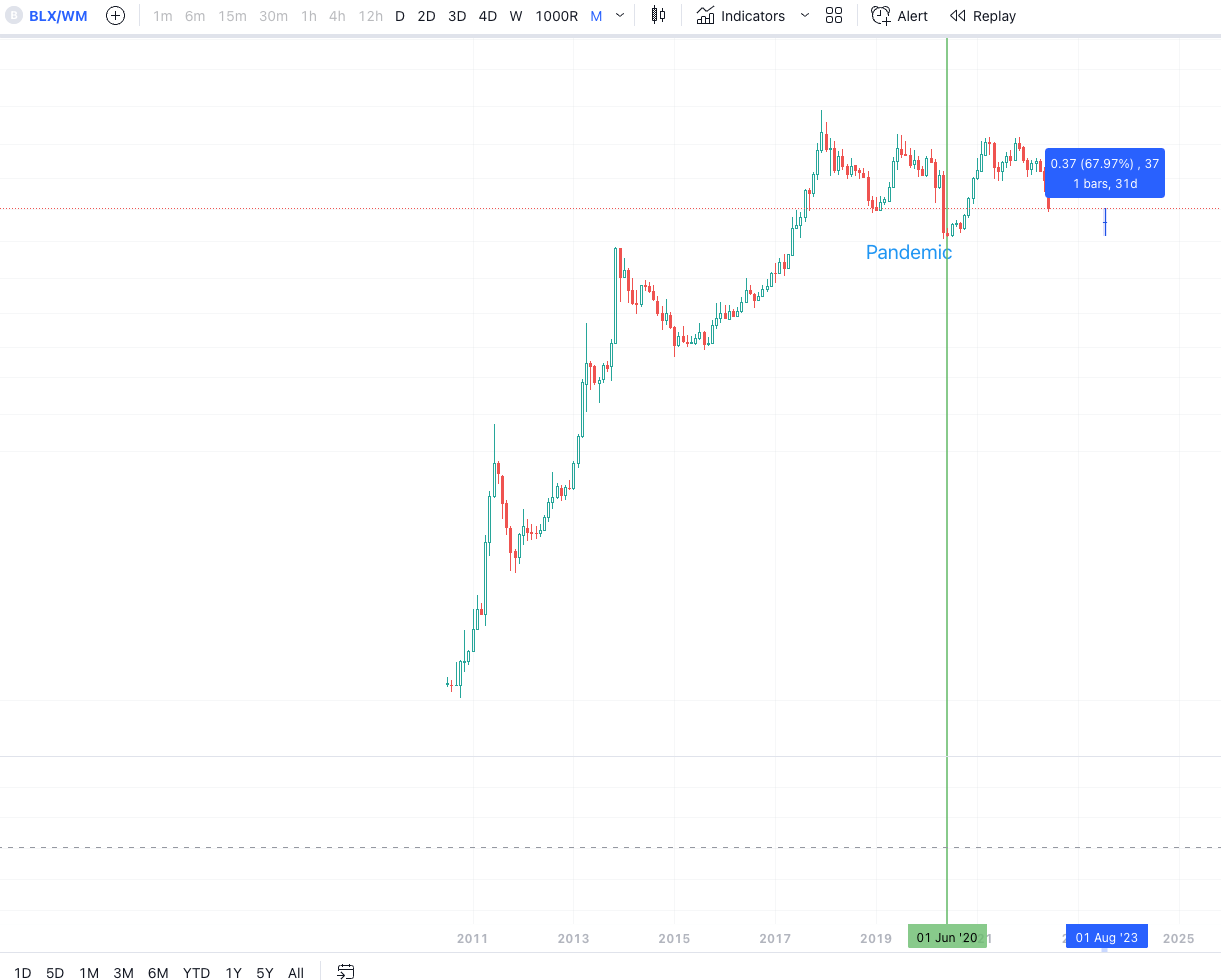Crypto Hopium Shots 1 — It Is All Going to Zero
What is actually going to zero is not what you think.
You are most likely reading this, because you are scared. The price of BTC sank just below 18k over the weekend, and you can hear all the voices on Twitter, and in the real world echoing that BTC is going to zero.
Hey, maybe you can even hear this man’s voice in your head:
You see, like Covid, communal human emotion is contagious. So here, I am, Chairman of Kaicho serving with you Hopium that will likely help you beat away the fear, at least a little bit. I have to be honest. I let that human emotional contagion get to me. Funny isn’t it? My partner, Patrick and I have been preparing for these very circumstances we are experiencing in the broader markets, for nearly a year now. We knew it was coming. We had begun to prepare. We profited off it. It’s happening, and yet, for a few moments, the fear kicked in. Wild.
With that said, We are of the belief that there is always some value to being contrarian — of course not contrarian-just-because in the annoying way that people can sometimes be. But contrarian, because the most upsides, that we have ever enjoyed in this space, have come from moments of taking the other side of the bet from the mainstream. It is in aid of this practice of being functionally contrarian that we (here at Kaicho) are taking the other side of the emotional scale. Everybody is scared? Doom-posting? Saying it is all going to zero? Well, it should be fun to take the other side of the bet isn’t it?
We’ll find out.
With this said, it is important to make completely clear that:
We are not writing this series as a motivation for YOU to double-down on any bad investments.
We are simply going down to first-principles to look at exactly where we began to build our convictions in Crypto from, and start from there.
The Macroeconomic variables for ALL MARKETS is still terrible.
Anything you see here, or in the rest of the series is for a more long term timeframe than say next week, or next month. So be advised.
And of course, the usual caveats about nothing in this missive being financial advice and other stories.
Without further ado, we give you Hopium 1.
Let’s get the baseline things out of the way, so we can have a decent context. From first principles, if you leave out the sensational parts about outsized returns and fortunes lost, the game of investing is really about two levers.
The first lever is about maintaining the current value of your wealth. The second lever is about increasing the the future value of your wealth. The purpose of the first lever, really is to make sure that what ever quantum of wealth you have captured and retained for yourself, remains that way.
This is where the ideas around avoiding loss, and factoring in thoughts about inflation come from. When we have avoided loss, through the first lever, we can then progress to increasing the size of our wealth, using the second lever.
So hold that thought.
There are a few “stores of value” that people utilise in attempting to push the first lever (and if the second lever is pushed as well, that’s awesome). Of course, we have Stocks, Bonds, Precious Metals and the like. For the truly “sophisticated” investor, you will see some mix of these different avenues in their portfolio depending on their age, their risk appetite and so forth. Again, if we go back to our first principles, our first lever pretty much means that, barring anything else, your chosen store of value shouldn’t lose its value consistently over time, right?
Since we’re agreed, let’s dive right into it. We will look at some charts stores of value, and as we do, we want you to imagine that you had put all your savings in each one (for this thought experiment).
As for the charts, you can call them visual aids. Don’t get intimidated by them. For our conversation, they really are a way for you to visualise value over time.
With that said, we will start with Gold.
What can you see from this chart? Ok so Gold had an amazing decade from the 70s (this is around the last time that inflation levels were as high as they are now). So we can infer that people were using Gold to try to make sure that their wealth was protected from inflation. It looks like the people who made that choice, made a good call. But then from the early 80s right down to the early 2000s, it took a beating and then caught a second wind. If you are familiar with financial history, the early 2000s coincides with the Dot Com Bust and its attendant recession. Hmmm, so it looks like invest seem to trust Gold when things aren’t going so great.
So we are focusing on the first lever, right? Good. So focusing on the first lever, if you are concerned about things going wonky with other stores of value, on the surface, it would seem that Gold is a good choice to make. Right? Good.
And it looks like a bunch of people use Gold as an inflation hedge. Inflation. That dirty word. We won’t go too deeply into the weeds with this one. However, one (slightly debatable) good heuristic we can use to visualise inflation over time is the amount of money a Central Bank prints and introduces into its economy. Since we live in a Petrodollar world, let’s take a look at the amount of money the US Central Bank — The Federal Reserve (fondly called The Fed), has printed over time.
What can you see? It is nothing too dramatic. You have to jocularly wonder what the budget for ink looks like, over time. You could make an argument that as the US economy has grown over time, the need to print money, has grown as well, right? No problem.
However, there are interesting areas on the chart. It looks like from the mid-90s until 2008, the money printing had sort of plateaued out. And then the money printing mirrors the rate of increase that we see, at the beginning of the chart. Again, if you remember that the 70s had high inflation, it kind of makes sense. However, things get interesting at the second green vertical line.
The money supply grew by 305% in an attempt to salvage the economy, after the pandemic. That’s huge.
Hold that thought. This is the second thought you will hold.
So we’re going to do a little bit of alchemy here. And it’s this: we are going to smash together two charts. Back to first principles, we are trying to make sure that whatever store of value we choose, is able to move the first lever. And that is making sure we are not losing money. And we’ve identified inflation as a concern, yes? And we’re using the money supply as a proxy for that, right? Then it stands to reason that what ever store of value we choose — we are starting with Gold — has to by necessity (if it is to satisfy pushing the first lever) has to grow, in a consistent manner in a way that outpaces the growth in the supply of money, yes?
Good, so we are on the same page.
What does Gold look like when compared against the growth in money supply?
So at first, the movement of Gold clearly mirrors happenings through the time ie. in the rough times people thought it was a good store of value, and this reflected in its value, even when the printing was aggressive in the 70s. And once the printing slowed, people piled out as well (probably seeking other stores of value). Of course, investors came running back when the money printing restarted with a vengeance.
Nothing dramatic happened until 2020. That massive rise in the money stock of >300%, resulted in a >78% dump in the value of Gold against a proxy for inflation. Yikes.
Okay maybe you can argue against Gold being able to retain value over time. No problem. Let’s try again with Stocks?
This is what the S&P500 looks like, over the years. Oh, the buy-and-hold gang, would love this one.
What does this same S&P500 look like, against the indomitable Fed Money Printer?
LOL. It stood no chance.
Okay okay. I mean they’re stocks right. They can be tricky. How about we try looking at Bonds? Bonds are safe haven. Like you really cannot go wrong with Bonds, right?
Let us take a look at the 20+ Year Treasury ETF
Ok. Not bad. A little dramatic there at times, with all that volatility though. But how does it look, in the face of all that money printing?
At least, Gold and Stocks put up a fight. With Bonds, it’s been a literal — as we say on Crypto Twitter — Down Only. That looks really rough.
Okay, let’s look outside the box a little bit. Let us try something unconventional like Oil? It may not be a fair fight though, but let’s see. Shall we?
We can’t even say that Oil has fared horribly in comparison to the others.
You are here for the Hopium, and that’s okay. Now shall we take a look at your dose of Hopium today. Bitcoin?
And here we have Bitcoin vs Money Printing (notice how we didn’t even bother with the Bitcoin Chart):
Let’s put what we are looking at, into perspective for just a second now.
If you: Bought 100 bars of Gold, Spent a Million dollars buying US Treasuries, Spent same amount on the S&P500 Index or you had spent that same amount of money during the Pandemic, or you had bought Bitcoin with that same money; only one of those assets would not have failed you.
With the others, you would be down by at best -60% or close to -90%
If you ever wondered why people said BTC is an inflation-hedge, maybe this gives some perspective. Understand that, this is even with BTC down 70% from its All-Time Highs from November 2021.
To be honest, it is anybody’s guess, what happens to BTC from here. Heck, arguments can be made that Bitcoin has been around for ONLY one decade, and the others have had several decades. Which is true. It is something to consider, and hold on to.
However, as an investor, even if you ignore the Bitcoin vs Money Printing Chart, you should seriously give a rethink to all the other ways you have stored your wealth in the past, and particularly since the Pandemic.
For us, here at Kaicho, this little tidbit, was profound and scary all at once in many ways. The first is that the hidden cost of Central Banks’ money printing becomes apparent. The second is that, a lot of what gets the spotlight in the Web3/Crypto space, misses this pivotal fact. This is a conversation ender.
And this, dear friends, is your first shot of Hopium.
You are welcome.
Chairman
****
Enjoy this rad EDM Remix of Dan Pena’s declaration:














